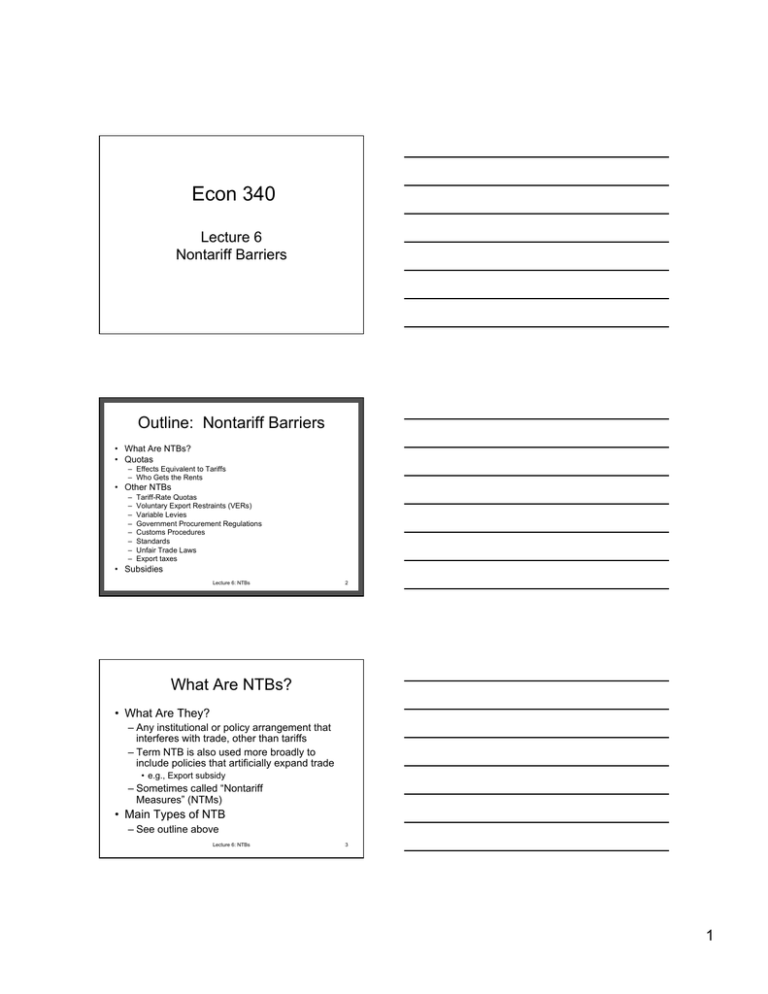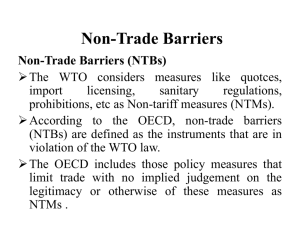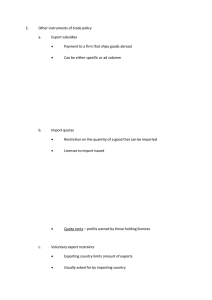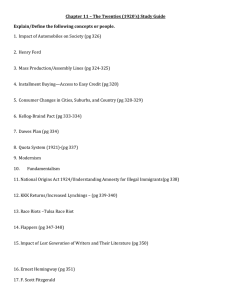Econ 340 Outline: Nontariff Barriers Lecture 6 Nontariff Barriers
advertisement

Econ 340 Lecture 6 Nontariff Barriers Outline: Nontariff Barriers • What Are NTBs? • Quotas – Effects Equivalent to Tariffs – Who Gets the Rents • Other NTBs – – – – – – – – Tariff-Rate Quotas Voluntary Export Restraints (VERs) Variable Levies Government Procurement Regulations Customs Procedures Standards Unfair Trade Laws Export taxes • Subsidies Lecture 6: NTBs 2 What Are NTBs? • What Are They? – Any institutional or policy arrangement that interferes with trade, other than tariffs – Term NTB is also used more broadly to include policies that artificially expand trade • e.g., Export subsidy – Sometimes called “Nontariff Measures” (NTMs) • Main Types of NTB – See outline above Lecture 6: NTBs 3 1 Outline: Nontariff Barriers • What Are NTBs? • Quotas – Effects Equivalent to Tariffs – Who Gets the Rents • Other NTBs – – – – – – – – Tariff-Rate Quotas Voluntary Export Restraints (VERs) Variable Levies Government Procurement Regulations Customs Procedures Standards Unfair Trade Laws Export taxes h ug ro e th hes o t ly l lg f e’l e o ua W om ivid s nd i • Subsidies Lecture 6: NTBs 4 Outline: Nontariff Barriers • What Are NTBs? • Quotas – Effects Equivalent to Tariffs – Who Gets the Rents • Other NTBs – – – – – – – – Tariff-Rate Quotas Voluntary Export Restraints (VERs) Variable Levies Government Procurement Regulations Customs Procedures Standards Unfair Trade Laws Export taxes • Subsidies Lecture 6: NTBs 5 Quotas • Definition: An import quota is a direct restriction on the quantity of an import – E.g., US might limit the imports of steel to some number of tons per year – Until Jan 1, 2005, US and EU had elaborate import quotas on many textile and apparel products from developing countries – We still have quotas on many agricultural products, e.g., sugar, cheddar cheese, dried milk, etc Lecture 6: NTBs 6 2 Quotas • Effects of a quota – If permitted quantity is above what would be imported anyway, then no effect at all. (True only with perfect competition) – Otherwise, quota creates scarcity and raises price – Quota raises domestic price above world price • For market to clear, domestic price must rise to the point that desired imports equal the quota • See this with supply and demand • First note example of US quota on sugar.. Lecture 6: NTBs 7 http://public.wsu.edu/~hallagan/EconS327/weeks/week5/Sugar/ Sugarquota301.html Lecture 6: NTBs 8 Effects of a Quota: Small Country P S Pa Suppose quota limits imports to this amount Quota PW D QS0 QD0 Lecture 6: NTBs Q 9 3 Effects of a Quota: Small Country P S Pa Suppose quota limits imports to this amount Quota which is less than initial imports PW D Quota QS0 QD Q 0 Lecture 6: NTBs 10 Effects of a Quota: Small Country P S Pa Then price must rise until D-S=Quota PW D Quota QS0 Q QD0 Lecture 6: NTBs 11 Effects of a Quota: Small Country P S Thus price is… Pa PQ riff “Ta lent” a iv PW Eq u Quota D QS0 QD0 Lecture 6: NTBs Q 12 4 Effects of a Quota: Small Country P S …and quantities are Pa PQ iff Tar lent a v i PW Equ D Quota QS0 QS1 QD QD 1 Q 0 Lecture 6: NTBs 13 Effects of a Quota: Small Country P S Effects on Welfare Pa PQ iff Tar lent a v PW qui E Same as tariff, except c a b c d D Quota QS0 QS1 Q QD1 QD0 Lecture 6: NTBs 14 Effects of a Quota: Small Country P S • Results – Suppliers gain area +a PQ a – Demanders lose area P W −(a+b+c+d) – Somebody gets area c, but who? b c d D Q • Area c is called “quota rents” – It is the profit from buying at world price, PW, and selling at higher domestic price, PQ Lecture 6: NTBs 15 5 Effects of a Quota: Small Country • Who gets quota rents? • Depends on how quota is administered: – First-come, first-served: Rents go to whoever gets there before quota is exhausted – Sell (or “auction”) import licenses: Rents go to government as revenue from sale of licenses – Give import licenses away to domestic people or firms: those people or firms then get the rents – Give licenses away to foreign firms or governments: foreigners get the rents • Most common is the last: Give away to foreigners in proportion to their historical exports Lecture 6: NTBs 16 Effects of a Quota: Rent Seeking • “Rent Seeking” – Defined as the use of resources in effort to get rents – Examples • Faster (thus more costly) transport to win race to border for 1st-come-1st-served quota • Lobbying legislators to get quota allocations • Inefficient production intended to get market-sharebased quota allocations Lecture 6: NTBs 17 Effects of a Quota • Effects of quota compared to tariff – Effects on price and quantity are the same • hence “tariff equivalent” – Effect on welfare is different if quota rents are lost to rent seeking and/or accrue to foreigners: • In that case, importing country loses more from quota than from equivalent tariff • What if country is large? – Picture is also same as for tariff – But if quota rent is lost or goes to foreigners, importing country cannot gain Lecture 6: NTBs 18 6 Effects of Quota: Large Country (if Rent given to foreigners) Summary: P Domestic Country: • Suppliers gain +a’ • Demanders lose −(a’+b’+c’+d’) • Net effect on country = −(b’+c’+d’) Foreign Country: • License holders gain +(c’+e’) • (Supplier/Demanders also lose) S a’ b’ c’ e’ d’ D Q Lecture 6: NTBs 19 Effects of a Quota • Other effects of a quota – Quality upgrading • Limited to a fixed quantity, foreign exporters seek higher value by improving quality – Like a tariff, quota may induce foreign firms to produce here – Unlike a tariff, the quota becomes more restrictive if foreign supply increases or world price drops Lecture 6: NTBs 20 Effects of a Fall in World Price P S Wi t Do h Ta me riff s , Wo Price tic uld F to P all T′ Pa iff Tar lent va i u Eq rows G PQ PT′ PW PW′ Quota QS0 QS1 QD1 QD0 Lecture 6: NTBs D Q 21 7 Outline: Nontariff Barriers • What Are NTBs? • Quotas – Effects Equivalent to Tariffs – Who Gets the Rents • Other NTBs – – – – – – – – Tariff-Rate Quotas Voluntary Export Restraints (VERs) Variable Levies Government Procurement Regulations Customs Procedures Standards Unfair Trade Laws Export taxes • Subsidies Lecture 6: NTBs 22 Other NTBs: Tariff-Rate Quota (TRQ) • This is two tariffs, separated by a quota – Low (or zero) tariff applies to imports below the quota – High tariff applies to imports above the quota Tariff • Used by US on many agricultural products • Effect is like – a low tariff, – a quota, – or a high tariff, depending on levels of supply and demand Lecture 6: NTBs Imports Quota 23 Other NTBs: Voluntary Export Restraint (VER) • Restriction of exports – At request of importing country – Usually specified as maximum quantity • This was the major form of protection for the US auto industry in the 1980s: US persuaded Japan to limit exports of cars to US • Illegal since 1995 under WTO rules – But how to enforce – Examples in 2012 that look like VERs • Effect is exactly like a quota allocated to foreigners Lecture 6: NTBs 24 8 Other NTBs: Variable Levies • A tariff that is changed as necessary to keep domestic price at a specified level • These are used extensively by the European Union as part of its Common Agricultural Policy (CAP) • Effects are same as a tariff, except for behavior over time Lecture 6: NTBs 25 Other NTBs: Government Procurement Regulations • Government favors domestic suppliers in buying goods and services – Buys only from domestic firms, or – Buys from domestic firms unless imports are, say, 10% cheaper • US used to have a “Buy American” law – Some say we need it again, but would violate WTO • Effect is like a tariff, except that loss to demander is now loss to government and thus taxpayer Lecture 6: NTBs 26 Other NTBs: Government Procurement Regulations • “Buy American” was part of the Stimulus Package of the US in 2009 – Congress would have imposed broad restrictions – Obama got them to restrict only when not contrary to US commitments under trade agreements – Even so, result was broadly restrictive, because purchasers were not sure of rules, so avoided imports – Result was also that other countries included similar provisions in their stimulus packages – See reading by Hufbauer and Schott. Lecture 6: NTBs 27 9 Other NTBs: Customs Procedures • All countries have customs procedures for maintaining border security and collecting tariffs • They become NTBs when – Excessive difficulty, or red tape, limits imports – Rules impose artificially high valuation for ad valorem tariffs Lecture 6: NTBs 28 Other NTBs: Standards • All countries also have standards, for – Health and safety (e.g., no lead paint) – Compatibility (e.g., 110 volt appliances) • They become NTBs when biased against imports in – Substance of the requirement – Procedures for certifying compliance Lecture 6: NTBs 29 Other NTBs: Unfair Trade Laws • The (legal) threat and use of – Anti-Dumping Duties – Countervailing Duties • We’ll say more about this later, in lecture about U.S. Trade Policies • These are NTBs if – “Unfair trade” is actually normal trade (it usually is) – The threat of action discourages trade, even when duties are not levied (the “chilling effect”) Lecture 6: NTBs 30 10 Other NTBs: Unfair Trade Laws • Use of these laws is increasing rapidly by other countries. See Lindsey and Ikenson – In 1990s, antidumping use increased 50% over the ‘80s. – Developing country AD cases: • 7 in 1980-87 • Over 700 in 1995-2000 – Leading users of AD (1995-2000) • US (323), EU (143) (out of 976 total) – Targets of AD cases (1995-2000, per year): • Leading: China (179), Japan (78), US (65) • Developed countries 355; Developing countries 656 Lecture 6: NTBs 31 Other NTBs: Unfair Trade Laws • Somewhat more recently: • Newly Initiated Antidumping Investigations, 1Q 2007–3Q 2009 • Source: Global Antidumping Database. Lecture 6: NTBs 32 Other NTBs: Export Taxes • Simply a tax on exports, analogous to tariff on imports – Effects are similar – Not common, until recently, because countries think exports are good – Became common in mid-2008, as high world prices for agriculture led food exporters to protect their own consumers Lecture 6: NTBs 33 11 Other NTBs: Effects of Export Tax – Small Country P S D PW Tax PW-t Q Lecture 5: Tariffs 34 Outline: Nontariff Barriers • What Are NTBs? • Quotas – Effects Equivalent to Tariffs – Who Gets the Rents • Other NTBs – – – – – – – – Tariff-Rate Quotas Voluntary Export Restraints (VERs) Variable Levies Government Procurement Regulations Customs Procedures Standards Unfair Trade Laws Export taxes • Subsidies Lecture 6: NTBs 35 Subsidies • Government assistance to producers – Export subsidy: paid only for exports – Domestic subsidy: paid for all production (but increases exports or reduces imports) • Effect on the subsidizing country – In competitive industries, country loses – Subsidies usually are intended to benefit producers, not country – In non-competitive industries, result may be different (recall Boeing-Airbus example) Lecture 6: NTBs 36 12 Effects of a Subsidy on Foreign Countries • Effect, if country is large, is to reduce the world price of the exported good • Subsidy expands supply in subsidizing country (which is part of SW0) World Market PW SW0 SW1 PW0 PW1 DW QW Lecture 6: NTBs 37 Effects of a Subsidy on Foreign Countries • Effects on other countries depend direction of their trade: – If they import the good, they gain – If they export the good, they lose See this in the following figures… Lecture 6: NTBs 38 Effects of Export Subsidy: on Foreign Importer P PW0 PW1 S Effects on Welfare Suppliers lose Demanders gain Country gains + (b+c+d) a b c d D QS1 QS0 QD0 QD1 Lecture 6: NTBs Q 39 13 Effects of Export Subsidy: on Foreign Exporter P S PW0 PW1 a c b d Effects on Welfare Suppliers lose Demanders gain Country loses −c D QS0 QS1 QD1 QD0 Q Lecture 6: NTBs 40 Effects of a Subsidy on Foreign Countries • In both cases – Foreign suppliers lose – Foreign demanders gain – Net effect on countries depends on • Whether they are net importers or exporters • Thus whether price change is improvement or worsening of their terms of trade • Optimal policy response for foreign countries – Importers: Write “thank-you note” (Krugman) – Exporters: Not much they can do Lecture 6: NTBs 41 Subsidies: Are They Used? • YES!! • US, EU, Japan all have large subsidies on many agricultural products • These reduce world prices and hurt producers of these products in developing countries • Examples of US subsidies and whom they hurt: – Corn: Mexico – Sugar: Caribbean countries – Cotton: Certain African countries Lecture 6: NTBs 42 14 Next Time • Reasons for Protection If tariffs are such a bad idea, why are they used? Lecture 6: NTBs 43 15





